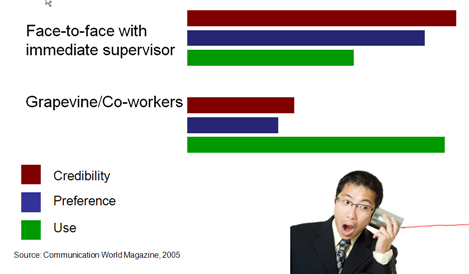Today’s featured blogger is Jennifer Miller. This post complements the Communication section in From Bud to Boss. For more information about the grapevine as it relates to communication, join our book community to read the Bonus Byte on this topic.
It was a typical day for Pete, a division manager who oversees the work of 1200 employees for a large multi-national enterprise. Like many others, the day was full of meetings, deadlines and urgent tasks, when one issue rose above the rest: rumors had surfaced that the company was planning on selling off one of its subsidiaries and would then reorganize the remainder of the company. The source of the rumor: a leading industry blog. Pete had a staff meeting with his direct reports planned for later in the day to make the announcement, but the grapevine had already beaten him to the punch.
The company grapevine is nothing new, but it now has a super-charged conduit via social technologies such as blogs, Facebook and Twitter. Leaders have always played a key role in disseminating information to their teams. Now, with the increased speed and access that employees have to information, the emphasis for leaders has shifted from that of acquiring and sharing information with employees to the interpretation and assimilation of that data. As shown by Pete’s story, the information now comes from multiple (and potentially uncontrolled) sources and often puts the leader in a reactive position.
Now, more than ever, it’s key for leaders to help give context to the information that employees have in their possession. In Pete’s case, because he was a latecomer to the information sharing, he did not have the chance to frame the information in a way that was best for the audience receiving it. Therefore, when he did lead his staff meeting, he had to start with: “I understand that some of you have heard X; here’s what this means to all of us.”
People crave answers, especially when a sudden, uncertain future appears before them. In a blog post for the Center for Creative Leadership, Doug Riddle wrote “Humans are conclusion-drawing animals and we will never leave dots unconnected.” Yes, people will go to extraordinary lengths to connect those dots, even displaying contradictory behaviors in the name of forming a “conclusion.” In a 2005 study reported by Communication World Magazine, employees listed their number one preferred source of information as a “meeting with their direct supervisor”, citing it as the most credible. Interestingly, however, employees stated that although they deemed the company “grapevine” as one of the least credible sources of information, it was their most-used source of initial information-gathering, even prevailing over a meeting with their supervisor. See figure.
Where Do Employees Get Their Information?
It would appear that the need to get some form of information quickly supersedes the need for reliable information. This is puzzling behavior to be sure, but helpful for a leader to know. Leaders who understand this aspect of human nature can better prepare themselves to “connect the dots” for their contributors. Here are six ways a leader can provide context when sharing information:
Ask: “What do you think this means?” Leaders are always surprised to hear the variety of interpretations that people ascribe to the “same” data. Listen for misinformation and be sure to clarify inaccurate data.
Discuss how this information will impact the team’s daily work. Identify to what degree the information being discussed will cause a disruption in team members’ daily work tasks. Identify a plan to help minimize the disruption.
Connect it back to your group’s goals. This is especially important if the information doesn’t seem relevant to the team. Help them see how what they do on a daily basis does connect to the information.
Ask: “Who else needs to know this?” Often, key groups are overlooked or are brought into the loop late. Your team most likely can help you find the key players who may not yet know information necessary to help your team make an informed decision.
Have some fun with the grapevine. One especially clever leader I know helped her team ease the anxiety of an impending change by asking team members to name the most outlandish rumors that had surfaced related to the change. Not only does this acknowledge the existence of a grapevine, but it can help alleviate the stress associated with inaccuracies of the rumor mill.
Keep it on the front burner. Before wrapping up the meeting, ask, “When should we reconnect to revisit this issue?” By keeping the issue from fading into the sunset, you signal to your team that you’re committed to helping them work through the issue at hand.
There’s little leaders can do the slow the speed with which information now travels throughout the workplace. With some advance planning, and a nod to human nature, they can however be prepared to help their teams wade through the onslaught of information in a way that builds team confidence and camaraderie.
Drawing on over 25 years’ management experience, Jennifer Miller helps emerging leaders “master the people equation” to navigate interpersonal interactions with professionalism and character. Read more of Jennifer’s work at The People Equation and the Lead Change Group blog. Connect with her on Facebook, Twitter, and LinkedIn.


0 comments